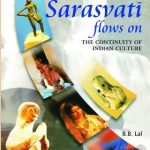US Numeric Size
Waist
US Denim Size
Hip
Chest
50 in stock
Author : B. B. Lal
Last hours of black friday promotion:
This book deals with two major controversies relating to India?s past. First. It has been asserted by many scholars, both Indian and foreign, that the Sarasvati mentioned in the Rigveda is the Helmand of Afghanistan. The author examines the entire Rigvedic evidence and demonstrates that it goes counter to aforesaid assumption. On the other hand, there are compelling geographical data in the Rigveda itself which unambiguously show that the Rigvedic Sarasvati is none other than the present-day Sarasvati-Ghaggar combine which flows through Haryana and Punjab. Though now it dries up near Sirsa, the dry bed, sometimes as much as 8 kilometers in width as picked up with Landsat imagery, shows that anciently it continued all the way down to the Rann of Kachchha. Second. It has no less vociferously been orchestrated that the Aryans ?invaded? India, as a result of which the Harappan Civilization became ?extinct?. The author shows that there is no evidence whatsoever to suggest any invasion, much less by the Aryans. On the contrary, there is ample evidence to demonstrate that many of the present-day cultural traits are rooted in the Harappan Civilization. Thus, you should not feel surprised if you travelled 4500 years back in time to a Harappan settlement and found a lady busy applying sindura (vermilion) to her manga (line of partition of the hair on the head), or a farmer ploughing his field in the same criss-cross pattern as do the Haryanavis or Rajasthanis today. If you wanted to place an ?order? for tanduri rotis, you could very well do so with a Kalibanganite 4800 years ago. Yogic asanas, which have new-found lovers even in the West, were as much a pride of the Harappans. Or, should you feel like being greeted with a namaste, a Harappan would be only too glad to oblige you. The soul of India lives on !
| Weight | 0.980 kg |
|---|---|
| Dimensions | 24 × 13 × 2.5 cm |
| Type | Hardbound |
| Language | English |
| Country of Origin | India |
| Year of publication | 2002 |
| Publisher | Aryan Books International |
| Delivery Time | 3-4 days |
| About the author | An archaeologist of International repute, Professor B.B. Lal was the Director General, Archaeological Survey of India, from 1968 to 1972. In the latter year, when he was only 51, he took voluntary retirement to pursue his research programmes independently. First he joined Jiwaji University, Gwalior, as a Professor and later the Indian Institute of Advanced Study, Shimla, of which he was also the Director. Professor Lal?s excavations cover a very wide range-from palaeolithic times to early historical. At Kalibangan, Rajasthan, he unearthed a prosperous city of the Indus Civilization. The excavations at Hastinapura, Indraprastha, etc. have established that there was a kernel of truth in the Mahabharata, even though the epic is full of interpolations. Likewise, his excavations at Ayodhya, Sringaverapura, etc. have indicated that the Ramayana too has a basis in history. In 1961, he conducted excavations in Egypt also, which threw valuable light n Egyptian prehistory. His publications include over 150 seminal research papers, published in scientific journals, both in India and abroad: USA, UK, France, Italy, Russia, Egypt, Afghanistan, Japan, etc. Amongst his latest books are: The Earliest Civilization of South Asia (1977); India ? 1947-97: New Light on the Indus Civilization (1998); In 1994, Professor Lal was awarded D. Litt. (Honoris causa) by Institute of Archaeology, St. Petersburg, Russia. The same year he was elected President of World Archeological Congress. He has been Chairman and member of several Committees of UNESCO. At home, in 1976 Asiatic Society, Bengal, awarded him S.C. Chakarvarti Medal; in 1979 Nava Nalanda Mahavihara conferred on him honorary degree of Vidya Varidihi; in 1982 Mithila Visvavidyalaya honoured him with the title of Mahamahopadhyaya. In 1991 three distinctions were conferred on him, respectively by the Indian Science Congress, Indian Archaeological Society and Asiatic Society, Bombay. In recognition of his multi-faceted contribution |
| Content | Preface, Acknowledgements, List of Illustrations, I. The Sarasvati in the Rigveda II. The Sarasvati on the Terra Firma III. The Most Ancient Civilization of the Sarasvati Valley IV. The Cultural Stream Flows on V. In Retrospect, Bibliography, Index |

Reviews
There are no reviews yet